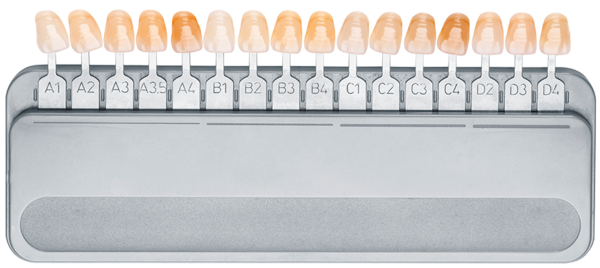Working correctly with the tooth shade table – for aesthetics and well-being for the patient
The most widespread shade scale consists of the VITA tooth shades, which - at least in Central Europe - form the basis for most tooth shade tables. The reason for this is that it is based on the common tooth colors in Central Europe, which were empirically recorded and reduced to the most common 16 shades.
The VITA classical A1-D4® shade scale results from these empirical findings. The 16 natural tooth shades have been supplemented by three bleach shades, which play a particularly important role in North America.
The 16 natural shades are classified into four shade categories:
A1 - A4 (reddish brownish)
B1 - B4 (reddish yellowish)
C1 - C4 (gray tones)
D2 - D4 (reddish grey)
VITA itself has already further developed its system because, in addition to the actual shade, brightness and color intensity are also decisive for tooth color.
The VITA SYSTEM 3D-MASTER® shade table was developed with this knowledge and on the basis of the VITA classical A1-D4® shade scale. It consists of 26 natural tooth shades supplemented by three bleach shades.
Since the colors look different with different material manufacturers, it is advisable for each dental laboratory to have its own “shade guide” created, with the full zirconia materials, which it mills itself or has milled in a production center. In this way, surprises relating to a mismatch in color can be avoided.
Tooth shades A1, A2, A3 and A3.5 from the VITA tooth shade tables
A is described as reddish-brownish and is probably the most typical natural color of teeth in Central Europe.
Within this color spectrum, the tooth shade A1 is the lightest shade, which only rarely occurs naturally. Tooth color A2 is also a rather lighter shade and is therefore mostly found in younger people, since natural discoloration is usually not that far advanced here. Tooth shade A3 has a medium degree of brightness and tooth shade A3.5 has a darker degree of brightness. These two tooth colors are most common in adult and elderly patients in Central Europe.
What is the composition of the tooth color?
Tooth color is largely determined by the dentine. The overlying enamel is colorless. The less enamel there is, the more intense and darker the tooth color appears.
In the case of dentures, in addition to the shade of the stump, material differences also affect the shade of the tooth. This depends on the density and opacity of the material. This is also the reason why different layer thicknesses when applying ceramic mass to the dentures lead to different color nuances and can therefore be used for individualization.
What should be considered when taking the color?
The dentures should integrate as naturally as possible into the existing teeth.
Since the opacity also plays a role in the tooth shade, daylight or light adapted to daylight should prevail when taking the shade. Bright clothing could distract or make the color of the teeth look different. The patient should therefore choose neutral-colored clothing for the appointment. In addition, make-up and especially lipstick should be avoided in any case. This could also stand in the way of natural color taking, since - as with the choice of clothing - it is distracting on the one hand and on the other hand optically distorts the colors.
In the meantime, digital aids can also be used to determine shades when taking them. In terms of patient satisfaction, however, the result must be coordinated with the patient.
How is tooth color determined?
The tooth color can be determined by the dentist or in the dental laboratory by dental technicians. Since patient satisfaction is not only related to the function, but also to the aesthetics of the dentures - no matter where the shade is taken - it is important that the patient feels comfortable with the shade chosen.
Usually, the dentist uses color rings or color scales. As mentioned above, tooth color depends on brightness, color intensity and hue.
A challenge when determining the tooth color can be that - due to discoloration - the teeth have different tooth colors even within a row of teeth.
But not only the color of the neighboring teeth is relevant when determining the shade. The color of the stump also plays a role, since it shines through, especially in the case of translucent restorations. In the case of all-ceramic dentures, the color of the die, material, translucency and layer thickness of the restoration as well as the indication and color of the fastening material must be taken into account in addition to the brightness, color intensity and hue.
The IPS e.max Shade Navigation App was developed for this complex task using Ivoclar materials. The tooth color can be determined with the app by entering the following information:
1. Entering the tooth shade
2. Entering the indication
3. Input of the stump shade
4. Entering the layer thickness
5. Input of the material
After selecting the basic shade from the shade guides, the dental technician in the dental laboratory can individually adapt (individualize) the tooth shade to the patient. At least when working with ceramic veneers.
OUR CONCLUSION
In addition to a natural look, it is particularly important that the patient feels comfortable with the chosen tooth color. A connection between aesthetics and well-being has already been established in various studies. This well-being should have top priority for dentists and dental technicians. That is why the appointments for taking the shade are also to be seen as consultation appointments in which dental technicians can share their experiences with the patients.
The tooth color tables are only to be seen as a guide to get a rough idea of the end result. Natural, aesthetically high-quality results are primarily achieved with individualization by the dental technician.
Do you need a shade guide with the zirconia which we offer at CADdent®? Contact us! Our experts will be happy to advise you.
